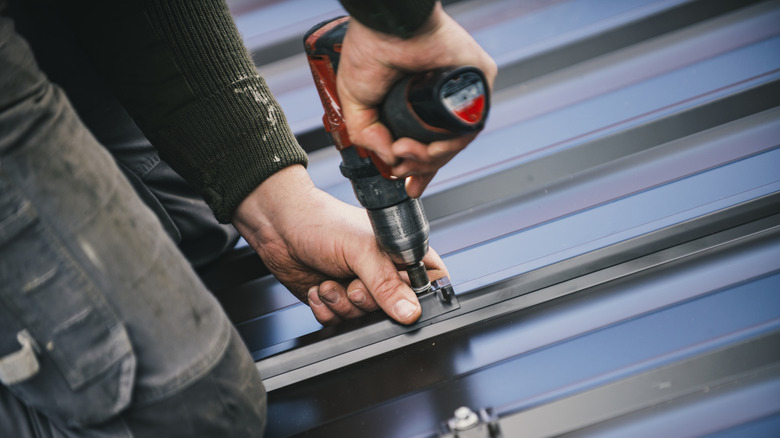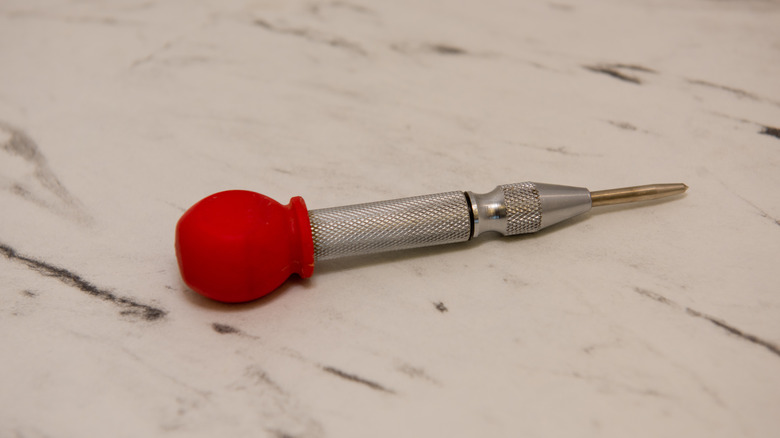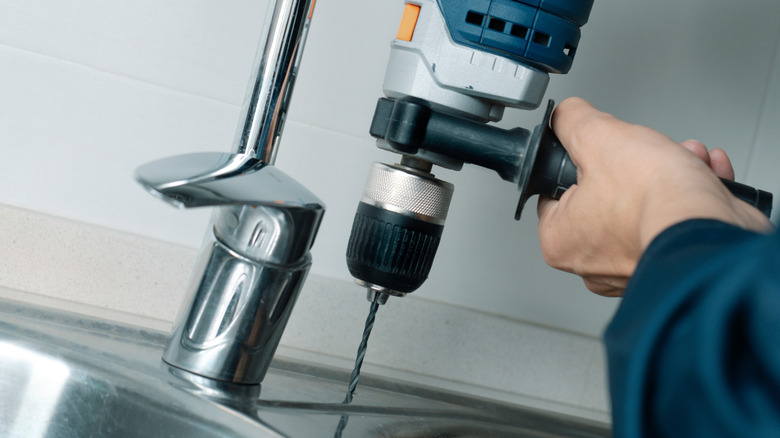The Tool You'll Want To Have On Hand When Drilling Metal
DIY projects that require you to drill through metal can be intimidating, but this task is totally doable as long as you have the right tools. However, if you're a beginner, you might need some help figuring out exactly what equipment will help you get the job done with ease. Thankfully, Ron Baker, House Digest's home improvement expert, revealed that a center punch is the tool you'll always want to have on hand when drilling metal.
"I would absolutely recommend a center punch before drilling any hole into metal," the expert said while speaking exclusively to House Digest. "The tool creates a dimple at the precise intended center of the hole. The twist drill's tip is held in position by this dimple, and without it a drill will tend to wander all over the place on metal."
Going without a center punch leaves you at risk of making mistakes that could ruin your project. The expert went on to explain why: "If you've drilled into metal — or tried to — without a center punch, you've experienced the tip of the drill bit skittering all over the place as if there's some dark force trying to prevent your drill from penetrating where you want it to."
Use a center punch to avoid these mistakes
There's a lot that can go wrong if you decide to drill holes into metal without using a center punch first. One major problem is that you increase the risk of drilling into the wrong spot. "Sometimes it doesn't matter much, and sometimes it's catastrophic," Ron Baker said of this mistake while speaking exclusively to House Digest. "If you're installing standing seam sheet metal to 2½-inch square steel tubing, it might not be a big deal. But if you need more accurate placement, like when you're machining basically anything, this imprecision just won't do."
Another error you might run into if you don't use a center punch is accidentally creating surface damage on the metal with your wandering drill. According to Baker, this could leave surfaces like painted or galvanized metals exposed to the elements and cause them to rust.
Additionally, you're at an increased risk of injuring yourself if you attempt to drill holes into metal without using a center punch first. This is because, while trying to maintain control of the drill, you will probably apply excessive pressure. "If the drill is small enough, or if you're using an impact driver, there's a meaningful chance you'll eventually break the drill bit," Baker said, revealing why this is dangerous. The moment the drill bit breaks, your hand could slam painfully against the metal. If you're working on a ladder, the sudden breakage and instability may even cause you to topple over onto the ground.
How to drill holes into metal safely
While speaking exclusively to House Digest, Ron Baker explained how to safely drill holes in metal. Along with using a center punch to help ensure your drill is aimed at the correct spot, you should also use the right lubricant. "Unless you're drilling through thin sheet metal, use a lubricant," the expert explained. "I tend to use thread-cutting oil for everything, but there are many options. Not lubricating will dull, weaken, and even break your twist drills." Using sharp drill bits is another helpful safety tip Baker recommended. He added that you should use bits specifically crafted for the type of metal you intend to drill into and keep them sharp. Drill bit sizing hacks can help you make the right choice too.
Baker went on to share a few center punch tool recommendations that will help you select the right product for your project. "You might get away with using a transfer punch as a center punch, but for the most part you want to keep things simple and use a center punch or a spring-loaded automatic center punch," he explained.
There are certain circumstances where you'll need to rely on the assistance of a hammer too. According to Baker, hammering the punch will help you control the force in some circumstances. Other times, a self-striking automatic punch is the better option. Stay away from an aligning punch altogether. "Its purpose is threading through multiple holes to align things with each other, and they're not designed to be hit with a hammer," Baker said of this tool.


